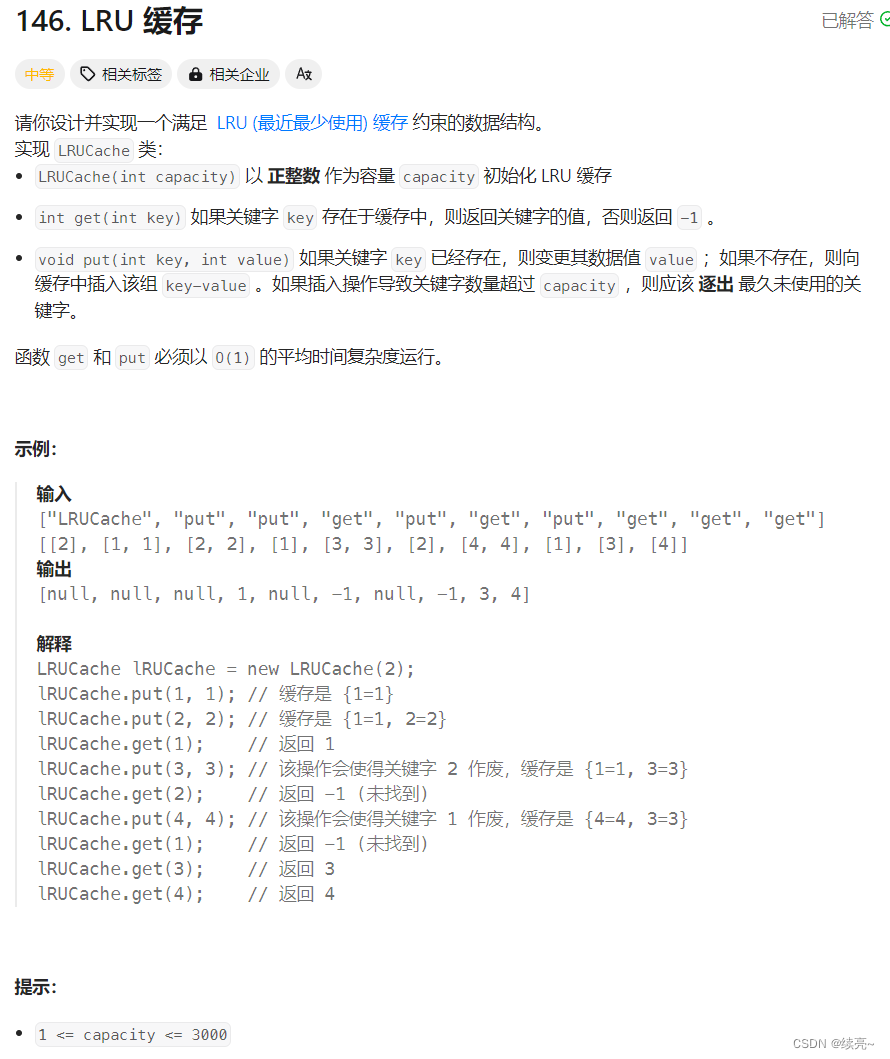35、链表-LRU缓存

思路:
首先要了解LRU缓存的原理,首先定下容量,每次get请求和put请求都会把当前元素放最前/后面,如果超过容量那么头部/尾部元素就被移除,所以最近最少使用的元素会被优先移除,保证热点数据持续存在。 不管放在头部还是尾部都可以。看你怎么定义
那么如何实现呢?有两种方式第一种直接继承LinkedHashMap 这个是已经帮我们实现的,代码如下:
class LRUCache extends LinkedHashMap<Integer, Integer>{
private int capacity;
public LRUCache(int capacity) {
super(capacity, 0.75F, true);
this.capacity = capacity;
}
public int get(int key) {
return super.getOrDefault(key, -1);
}
// 这个可不写
public void put(int key, int value) {
super.put(key, value);
}
@Override
protected boolean removeEldestEntry(Map.Entry<Integer, Integer> eldest) {
return size() > capacity;
}
}第二种就是手动去实现了,代码如下:
class LRUCache extends AbstractLRUCache<Integer, Integer> {
public LRUCache(int capacity) {
super(capacity);
}
public int get(int key) {
Integer ans = super.get(key);
return ans == null ? -1 : ans;
}
public void put(int key, int value) {
super.set(key, value);
}
}
abstract class AbstractLRUCache<K, V> {
private Map<K, Node<K, V>> keyNodeMap;
private NodeDoubleLinkedList<K, V> nodeList;
private final int capacity;
public AbstractLRUCache(int cap) {
if (cap < 1) {
throw new RuntimeException("should be more than 0");
}
keyNodeMap = new HashMap<>();
nodeList = new NodeDoubleLinkedList<>();
capacity = cap;
}
public V get(K key) {
if (keyNodeMap.containsKey(key)) {
Node<K, V> res = keyNodeMap.get(key);
nodeList.moveNodeToTail(res);
return res.value;
}
return null;
}
public void set(K key, V value) {
if (keyNodeMap.containsKey(key)) {
Node<K, V> node = keyNodeMap.get(key);
node.value = value;
nodeList.moveNodeToTail(node);
} else {
Node<K, V> newNode = new Node<>(key, value);
keyNodeMap.put(key, newNode);
nodeList.addNode(newNode);
if (keyNodeMap.size() == capacity + 1) {
removeMostUnusedCache();
}
}
}
private void removeMostUnusedCache() {
Node<K, V> node = nodeList.removeHead();
keyNodeMap.remove(node.key);
}
class Node<K, V> {
public K key;
public V value;
public Node<K, V> last;
public Node<K, V> next;
public Node(K key, V value) {
this.key = key;
this.value = value;
}
}
class NodeDoubleLinkedList<K, V> {
private Node<K, V> head;
private Node<K, V> tail;
public NodeDoubleLinkedList() {
head = null;
tail = null;
}
public void addNode(Node<K, V> newNode) {
if (newNode == null) {
return;
}
if (head == null) {
head = newNode;
tail = newNode;
} else {
tail.next = newNode;
newNode.last = tail;
tail = newNode;
}
}
public void moveNodeToTail(Node<K, V> node) {
if (this.tail == node) {
return;
}
if (this.head == node) {
this.head = node.next;
this.head.last = null;
} else {
node.last.next = node.next;
node.next.last = node.last;
}
node.last = this.tail;
node.next = null;
this.tail.next = node;
this.tail = node;
}
public Node<K, V> removeHead() {
if (this.head == null) {
return null;
}
Node<K, V> res = this.head;
if (this.head == this.tail) {
this.head = null;
this.tail = null;
} else {
this.head = res.next;
res.next = null;
this.head.last = null;
}
return res;
}
}
}以下是代码实现的功能要点:
-
AbstractLRUCache是一个抽象类,它包含了 LRU 缓存的核心逻辑,如添加节点、移动节点到链表尾部、移除最少使用的节点等。 -
LRUCache是AbstractLRUCache的具体实现,它提供了get和put方法来与缓存进行交互。这些方法调用了抽象类中的方法来实现 LRU 逻辑。 -
Node类代表缓存中的一个条目,包含键、值以及指向前一个和后一个节点的指针。 -
NodeDoubleLinkedList是一个双向链表,用于按照访问顺序维护缓存中的节点。最近访问的节点被移动到链表的尾部,而最少使用的节点位于链表的头部。 -
当缓存达到其容量限制时,最少使用的节点(链表头部的节点)将被移除,以确保缓存大小不超过设定的容量。
原文地址:https://blog.csdn.net/qq_29434541/article/details/137844552
免责声明:本站文章内容转载自网络资源,如本站内容侵犯了原著者的合法权益,可联系本站删除。更多内容请关注自学内容网(zxcms.com)!
